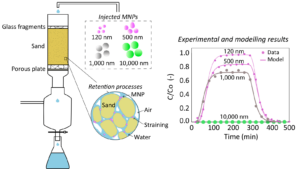

The presence of micro- and nanoplastics (MNPs) in the environment has raised increasing concern about their potential impact on ecosystems and environmental health, prompting further research on their effects. This new study by Fundacion IMDEA Agua on polystyrene micro- and nanoplastics sheds light on how these particles move through quartz sand under unsaturated conditions (i.e. a state where the soil or porous material contains both water and air, but the pore spaces are not completely filled with water), revealing potential risks for soil health and groundwater contamination.
The study highlighted the following key findings:
– Smaller MNPs (~120 nm) easily pass through sand, with ~95% recovery, meaning they’re highly mobile and could potentially reach groundwater.
– Medium-sized particles (500–1000 nm) show “size exclusion,” travelling rapidly in larger pathways and bypassing tighter spaces.
– Larger particles (10,000 nm) become trapped in sand, unable to pass through small soil pores—a process known as “straining.”
– Physical and chemical interactions: particle size and sand structure largely influence MNP movement. Modelling reveals that larger MNPs, though stable in suspension, are less likely to infiltrate deeper soil layers due to physical retention.
These discoveries entail some important environmental implications:
– Groundwater risks: smaller MNPs pose a contamination risk as they could carry harmful pollutants deep into soil layers, potentially affecting groundwater—a vital drinking resource.
– The “Trojan Horse” effect: mobile MNPs can act as carriers for other toxic chemicals, raising concerns over what contaminants they may bring into sensitive ecosystems.
– Soil health: larger, retained MNPs may accumulate in soil, impacting water retention, nutrient cycling, and potentially entering the food chain through soil organisms.
This research calls for continued study of MNPs in natural soils to better assess their impact on both ecosystem health and human safety. As plastic pollution continues to rise, understanding MNP movement is crucial for developing strategies to mitigate their impact.
Read the full study here: https://doi.org/10.1016/j.envpol.2024.125193